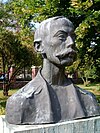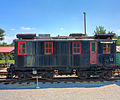Portal:Trains
Portals → Technology → Transport → Trains
The trains portal
|
In rail transport, a train is a vehicle or (more frequently) a string of vehicles capable of being moved along a continuous line of rails or other guideway for the purpose of conveying freight or passengers between points on a predetermined route. The train may be hauled or propelled by one or more vehicles designed exclusively for that purpose (locomotives) or may be driven by a number of motors incorporated in all or several of the vehicles (multiple units). As of 2018[update], there are approximately 1,052,000 kilometres (654,000 mi) of railway track in use worldwide. (World Bank (via Archive.org)) |
|
Selected article of the week
The General Electric steam turbine locomotives were two steam turbine locomotives built by General Electric (GE) for Union Pacific (UP) in 1938. The two units were streamlined, 90 feet 10 inches (27.69 m) in length, capable of producing 2,500 horsepower (1,900 kW), and reputedly able to attain speeds of 125 miles per hour (201 km/h). Stylistically, they resembled contemporary Electro-Motive Corporation (EMC) diesel designs, especially the UP's M-10003 through M-10006 trainsets. The two locomotives were delivered to UP in April 1939, and they completed test runs and participated in a variety of publicity events for the railroad, including the grand opening of the Los Angeles Union Passenger Terminal, the world premier of Cecil B. DeMille's film Union Pacific, and even an inspection by President Franklin D. Roosevelt. While the locomotives displayed excellent acceleration and an ability to maintain schedules better than conventional steam locomotives, they also demonstrated serious reliability problems and relatively high maintenance costs; they never entered regular revenue service. In June 1939, UP returned the locomotives to GE; by December 1941, the railroad had given up on the project. In 1941, the GE steam turbine locomotives were tested by the New York Central, and they were operated by the Great Northern in 1943 during the World War II "power crunch" (a lack of sufficient locomotives to sustain regular operations) before being retired from service later that year. Ultimately, they were scrapped before the end of World War II.
Recently selected: Flushing–Main Street (IRT Flushing Line) - Fenchurch Street railway station - Everett Station
Selected image of the week
Passengers board and debark from trains at Keleti railway station in Budapest, Hungary. The station, built in the 1880s, is named due to its position as the most eastern ('keleti') of the city's rail stations, nearest Transylvania and the Balkans.
Recently selected: bent rails in Guatemala - OSE passenger train - DRB 41 241 at Essen
Did you know...
- ...that the opening ceremonies of the Galway to Clifden railway were very sparsely attended because the event date was a strict church holiday and was reserved for attending church services?
- ...that following heavy damage to the Galveston Island Trolley track and cars from Hurricane Ike in 2008, substitute service with replica buses was operated until service resumed in October 2021?
- ...that although the former Santa Fe Railway's Galesburg station was demolished after regular passenger service to the station ended in 1996, the site is still used if derailments cause trains to use the Chillicothe Subdivision instead of the Mendota Subdivision?
- ...that the Fuzhou–Xiamen railway, which opened in 2010, was so heavily used that it reached capacity in 2015, spurring construction on the parallel Fuzhou–Xiamen high-speed railway for CRH passenger train services?
Selected anniversaries
- July 10
- 1869 – Kálmán Kandó (pictured), Hungarian engineer who designed the world's first AC traction electric railway in Italy in 1902, is born (d. 1931).
- 1893 – The Toronto and Mimico Creek Railway, purchased by William Mackenzie on July 1, is extended to Mimico Creek.
- 1911 – Six construction workers die in an accident while working on the Western Maryland Railway's Salisbury Viaduct.
- 1951 – Charles E. Johnston, president of Kansas City Southern Railway 1928-1938, dies (b. 1881).
Train News
- July 24, 2021 – Atchison, Topeka and Santa Fe No. 2926, a 4-8-4 steam locomotive built by Baldwin Locomotive Works in 1944, moves under its own power for the first time since Christmas Eve of 1953, after nearly twenty-two years of being rebuilt by volunteers. The locomotive will be put into mainline excursion service. (NMSL&RHS, Trains Magazine on Facebook)
- May 5, 2021 – Steamtown National Historic Site completes thorough cosmetic overhaul on Union Pacific 4-8-8-4 Big Boy No. 4012, which is moved back on static display before National Train Day. (NEPA Scene)
- April 2, 2021 – 2021 Hualien train derailment – A Taroko Express train operated by the Taiwan Railways Administration (TRA) derails at the north entrance of Qingshui Tunnel in Heren Section, Xiulin Township, Hualien County, Taiwan, killing 49 people and injuring at least 200 others. North of Hualien City a construction truck had fallen down a slope onto the tracks. The eight-carriage train derailed after colliding with the truck, and then came to a rest in the tunnel, with severe damage and many casualties. (Bloomberg, CNN, CNA, New York Times, Financial Times)
- December 31, 2020 – Following a complete restoration, Chesapeake and Ohio 1309, a 2-6-6-2 Mallet locomotive built by Baldwin Locomotive Works in 1949, the last steam locomotive built by Baldwin for the North American market, is operated under its own power for test runs. When returned to service on the Western Maryland Scenic Railroad, it will be the largest steam locomotive in regular scheduled service in the United States and take 2-8-0 No. 734’s place as the largest active steam locomotive in the state of Maryland. (Trains.com Newswire)
- September 28, 2020 – Amtrak operates a test run using one of the 28 new Avelia Liberty trains manufactured by Alstom along the full length of the Northeast Corridor to Boston South Station. Previous test runs had occurred from Washington, D.C., only as far north as New Jersey and Delaware. Barring any problems, the trains are expected to enter regular service on the route in 2021. (Universal Hub)
- June 13, 2020 – The Bay Area Rapid Transit Silicon Valley BART extension opened its stations in Milpitas and North San Jose. (San Jose Spotlight, SF Gate)
General images
WikiProjects
WikiProject Trains (Shortcut: WP:TWP)
- WikiProject Stations (WP:STA)
- WikiProject Streetcars (WP:TRAM)
- WikiProject Rapid transit (WP:RTPJ) inactive
- By region:
- WikiProject Metros of the former Soviet Union (WP:SOVMETRO) inactive
- WikiProject Indian railways (WP:INRW)
- WikiProject Trains in Japan (WP:TJ)
- WikiProject New Zealand Railways (WP:NZR)
- WikiProject Pakistan Railways (WP:PKR) inactive
- United Kingdom
- United States
- Fictional rail transport topics:
Note: WikiProjects marked as inactive are retained pending future editing activity
Subcategories
Things you can do
See also Wikipedia:WikiProject Trains/Todo and Wikipedia:Pages needing attention/Railroads
Associated Wikimedia
The following Wikimedia Foundation sister projects provide more on this subject:
-
Commons
Free media repository -
Wikibooks
Free textbooks and manuals -
Wikidata
Free knowledge base -
Wikinews
Free-content news -
Wikiquote
Collection of quotations -
Wikisource
Free-content library -
Wikiversity
Free learning tools -
Wiktionary
Dictionary and thesaurus
























































































